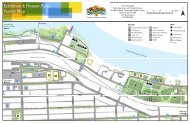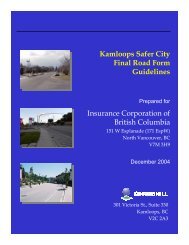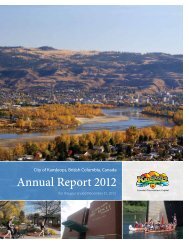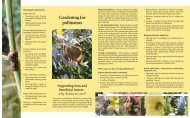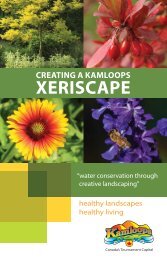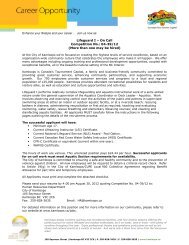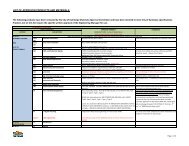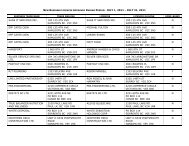Planting the seeds for a sustainable future - City of Kamloops
Planting the seeds for a sustainable future - City of Kamloops
Planting the seeds for a sustainable future - City of Kamloops
Create successful ePaper yourself
Turn your PDF publications into a flip-book with our unique Google optimized e-Paper software.
Intensity <strong>of</strong> ProductionFigure 10 shows <strong>the</strong> average revenue per hectare (<strong>of</strong> ALR land) generated by farms in several regional districts in <strong>the</strong> BCinterior.The TNRD is among <strong>the</strong> least intensively farmed areas.Increased revenue per hectare might be achieved withmore: irrigation; intensive use <strong>of</strong> fertilizers and o<strong>the</strong>r inputs; higher value crops;land clearing; andproduction <strong>of</strong> supply managed products orintensive livestock.$4,000$3,500$3,000$2,500$2,000$1,500$1,000$500$-$128 $347 $1,585 $1,935 $416 $1,035 $3,703 $60Farm size, in terms <strong>of</strong> revenue generated, is extremelyvariable. The vast majority <strong>of</strong> <strong>the</strong> economic activityoccurs on <strong>the</strong> large farms. The 26 largest farms (10.5%<strong>of</strong> <strong>the</strong> 248 farms) generate at least 68% <strong>of</strong> <strong>the</strong> area’sgross farm receipts. The 123 smallest farms (49.6%),with sales <strong>of</strong> less than $10,000 per year, cumulativelygenerate less than 6.7% <strong>of</strong> <strong>the</strong> area’s gross farm receipts.Figure 10 – Intensity <strong>of</strong> land use based on gross receipts per hectare <strong>of</strong> land in <strong>the</strong> ALR.On Farm CapitalThe total market value <strong>of</strong> farm capital increased by 22% between 2006 and 2011. The average increase in <strong>the</strong> value <strong>of</strong> farmcapital was $376,794 over 5 years or $75,359 per year. This is important <strong>for</strong> a couple <strong>of</strong> reasons:There is an old axiom that says, "farmers live poor, die rich". Income from operations has been negative over <strong>the</strong> past twocensus periods. The average is a net operating loss <strong>of</strong> $1,162 per year. If <strong>the</strong> increase in farm capital is included, <strong>the</strong> averagebecomes a gain <strong>of</strong> $74,167 per year. Farmers have been able to use, and have used, <strong>the</strong>se gains in capital values to borrowmoney <strong>for</strong> operations, effectively allowing <strong>the</strong>m to continue to operate at a loss.It essentially creates a succession issue. There is not enough operating cash flow in <strong>the</strong> farm to pay long-term debt. Newfarmers <strong>the</strong>re<strong>for</strong>e must buy in with very high levels <strong>of</strong> equity or have non-farm income to pay <strong>the</strong> mortgage.CITY OF KAMLOOPS 35




